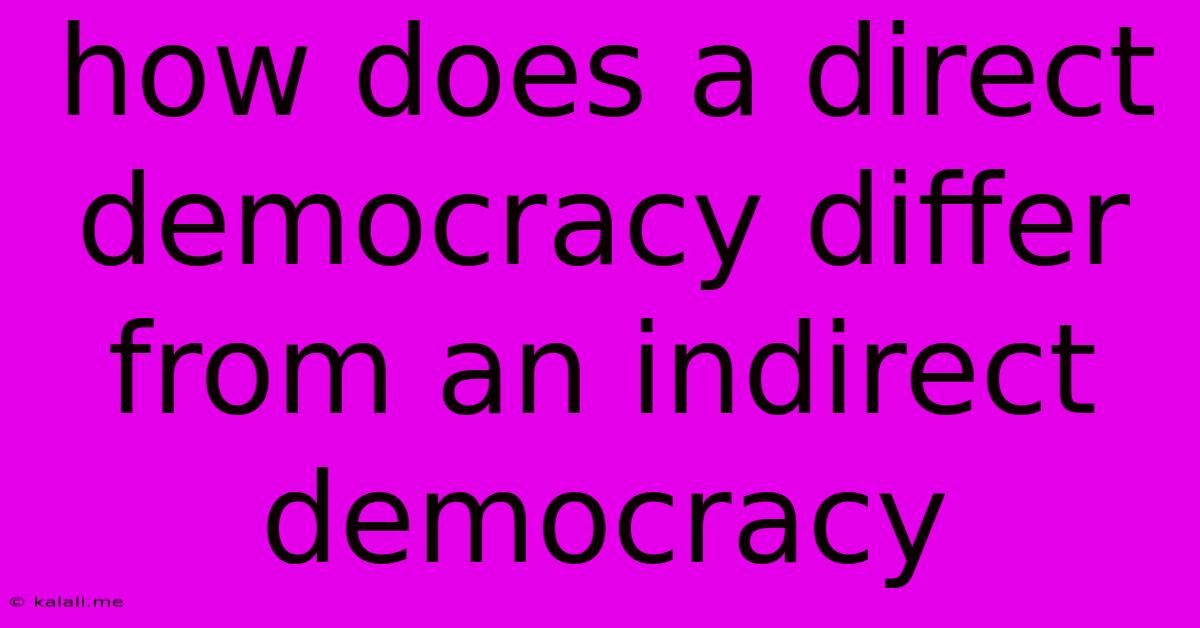How Does A Direct Democracy Differ From An Indirect Democracy
Kalali
Jun 12, 2025 · 3 min read

Table of Contents
Direct vs. Indirect Democracy: Understanding the Key Differences
Understanding the nuances between direct and indirect democracies is crucial for comprehending the complexities of modern governance. While both systems aim to empower the people, their mechanisms for achieving this goal differ significantly. This article will delve into the core distinctions between these two forms of democracy, highlighting their strengths and weaknesses. This will help you understand the fundamental differences between these two systems of government, and their implications for citizen participation and political decision-making.
What is Direct Democracy?
Direct democracy, also known as pure democracy, is a system where citizens directly participate in decision-making. Instead of electing representatives, the people themselves vote on policies and laws. This often involves referendums, initiatives, and citizen assemblies, allowing for a high level of citizen engagement and a direct voice in shaping government policy. Think of ancient Athens as a historical example, although even then, participation was limited to a small fraction of the population.
Key Features of Direct Democracy:
- Citizen participation: Direct involvement in the legislative process.
- Referendums and initiatives: Direct votes on specific policies or laws proposed by citizens or the government.
- High level of engagement: Increased political awareness and participation among citizens.
- Potential for majority tyranny: The risk of the majority overriding the rights of minority groups.
- Scalability issues: Difficult to implement effectively in large populations.
What is Indirect Democracy?
Indirect democracy, also known as representative democracy, is the more prevalent system in the modern world. In this model, citizens elect representatives to make decisions on their behalf. These representatives are responsible for formulating and passing laws, reflecting (ideally) the will of their constituents. Countries like the United States, the United Kingdom, and Canada operate under this system.
Key Features of Indirect Democracy:
- Representative government: Citizens elect representatives to make decisions on their behalf.
- Legislative bodies: Lawmaking is conducted by elected officials in parliaments, congresses, or other legislative bodies.
- Political parties: Often play a significant role in organizing and shaping the political landscape.
- Accountability: Representatives are accountable to their constituents through elections.
- Expertise and efficiency: Representatives can bring specialized knowledge and expertise to the decision-making process.
Comparing Direct and Indirect Democracy: A Table Summary
| Feature | Direct Democracy | Indirect Democracy |
|---|---|---|
| Decision Making | Citizens directly participate | Representatives make decisions on behalf of citizens |
| Citizen Role | Active participants in policy formation | Elect representatives and hold them accountable |
| Scale | Best suited for small communities | Suitable for large populations |
| Efficiency | Can be slow and cumbersome | Generally more efficient |
| Expertise | May lack specialized knowledge | Can leverage expertise of elected officials |
| Potential Issues | Majority rule can suppress minority rights | Potential for corruption and lack of representation |
Hybrid Systems: Blending the Best of Both Worlds
Many modern democracies employ a hybrid system, combining elements of both direct and indirect democracy. This often involves incorporating mechanisms like referendums and initiatives alongside a representative system. This allows for greater citizen input on specific issues while maintaining the efficiency and expertise of a representative government. Switzerland is a prime example of a country successfully utilizing a hybrid democratic system.
Conclusion:
Both direct and indirect democracy offer unique advantages and disadvantages. The optimal system for a given society often depends on factors such as population size, societal complexity, and the level of citizen engagement. Understanding the fundamental differences between these two systems is key to participating effectively in democratic processes and advocating for a government that truly represents the will of the people. The ongoing debate surrounding the best approach to democratic governance remains a vital component of political discourse worldwide.
Latest Posts
Latest Posts
-
Which Of The Following Reactions Is Not A Redox Reaction
Jun 13, 2025
-
In The Third Sentence Of The First Paragraph
Jun 13, 2025
-
California Polytechnic State University Sat Scores
Jun 13, 2025
-
How Many Lakhs Is A Million
Jun 13, 2025
-
Which Of The Following Is Correctly Matched A
Jun 13, 2025
Related Post
Thank you for visiting our website which covers about How Does A Direct Democracy Differ From An Indirect Democracy . We hope the information provided has been useful to you. Feel free to contact us if you have any questions or need further assistance. See you next time and don't miss to bookmark.